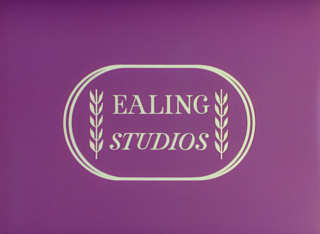
The Ealing comedies is an informal name for a series of comedy films produced by the London-based Ealing Studios during a ten-year period from 1947 to 1957. Often considered to reflect Britain's post-war spirit, the most celebrated films in the sequence include Kind Hearts and Coronets (1949), Whisky Galore! (1949), The Lavender Hill Mob (1951), The Man in the White Suit (1951) and The Ladykillers (1955). Hue and Cry (1947) is generally considered to be the earliest of the cycle, and Barnacle Bill (1957) the last, although some sources list Davy (1958) as the final Ealing comedy. Many of the Ealing comedies are ranked among the greatest British films, and they also received international acclaim.

Sir Michael Elias Balcon was an English film producer known for his leadership of Ealing Studios in West London from 1938 to 1955. Under his direction, the studio became one of the most important British film studios of the day. In an industry short of Hollywood-style moguls, Balcon emerged as a key figure, and an obdurately British one too, in his benevolent, somewhat headmasterly approach to the running of a creative organization. He is known for his leadership, and his guidance of young Alfred Hitchcock.
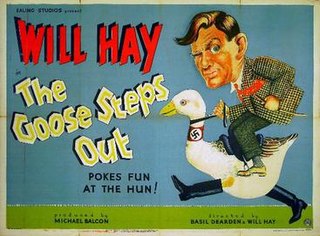
The Goose Steps Out is a British film released in 1942, starring Will Hay, who also co-directed with Basil Dearden. It is a comedy of mistaken identity, with Hay acting as a German spy and also an Englishman who is his double. It was the film debut of Peter Ustinov.

Ralph Douglas Vladimir Slocombe OBE, BSC, ASC, GBCT was a British cinematographer, particularly known for his work at Ealing Studios in the 1940s and 1950s, as well as the first three Indiana Jones films. He won BAFTA Awards in 1964, 1975, and 1979, and was nominated for an Academy Award on three occasions.

Basil Dearden was an English film director.

Khartoum is a 1966 British epic war film written by Robert Ardrey and directed by Basil Dearden. It stars Charlton Heston as British General Charles "Chinese" Gordon and Laurence Olivier as Muhammad Ahmed, with a supporting cast that includes Richard Johnson and Ralph Richardson. The film is based on historical accounts of Gordon's defence of the Sudanese city of Khartoum from the forces of the Mahdist army, during the 1884–1885 Siege of Khartoum. The opening and closing scenes are narrated by Leo Genn.
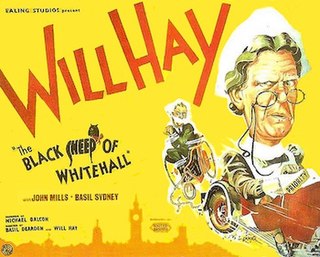
The Black Sheep of Whitehall is a 1942 British black-and-white comedy war film, directed by Will Hay and Basil Dearden, starring Will Hay, John Mills, Basil Sydney and Thora Hird in her screen debut. It was produced by Michael Balcon and Ealing Studios.

Michael Leighton George Relph was an English film producer, art director, screenwriter and film director. He was the son of actor George Relph.

Rockets Galore! is a 1957 British comedy film directed by Michael Relph and starring Jeannie Carson, Donald Sinden and Roland Culver. The sequel to Whisky Galore!, it was much less successful than its predecessor.

The Gentle Gunman is a 1952 British drama film directed by Basil Dearden and starring John Mills, Dirk Bogarde and Elizabeth Sellars. The film is based on a 1950 play of the same title by Roger MacDougall that was televised by the BBC in September 1950. It was produced by Ealing Studios. The film's sets were designed by the art director Jim Morahan.
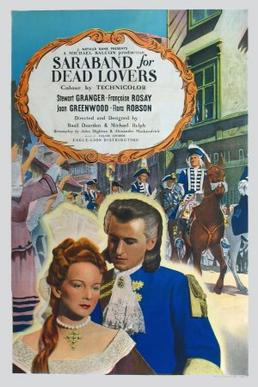
Saraband for Dead Lovers is a 1948 British adventure historical drama film directed by Basil Dearden and starring Stewart Granger and Joan Greenwood. It is based on the 1935 novel by Helen Simpson. Set in 17th-century Hanover, it depicts the doomed romance between Philip Christoph von Königsmarck and Sophia Dorothea of Celle, the wife of the elector of Hanover. The saraband mentioned in the title is a type of Spanish dance.

Spare a Copper is a 1940 British black-and-white musical comedy war film directed by John Paddy Carstairs and starring George Formby, Dorothy Hyson and Bernard Lee. It was produced by Associated Talking Pictures. It is also known as Call a Cop. The film features the songs, "I'm the Ukulele Man", "On the Beat", "I Wish I Was Back on the Farm" and "I'm Shy". Beryl Reid makes her film debut in an uncredited role, while Ronald Shiner appears similarly uncredited, in the role of the Piano Mover and Tuner.
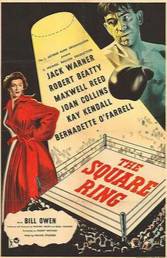
The Square Ring is a 1953 British tragi-comic drama, directed by Basil Dearden and made at Ealing Studios. It stars Jack Warner, Robert Beatty and Bill Owen. The film, based on a stage play by Ralph Peterson, centres on one night at a fairly seedy boxing venue and tells the disparate stories of the fighters and the women behind them.

Train of Events is a 1949 British portmanteau film made by Ealing Studios and directed by Sidney Cole, Charles Crichton and Basil Dearden. It begins with a train that is heading for a crash into a stalled petrol tanker at a level crossing and then flashes back and tells four different stories about some of the passengers.

The Rainbow Jacket is a 1954 British drama film directed by Basil Dearden, and featuring Robert Morley, Kay Walsh, Bill Owen, Honor Blackman and Sid James. It was made at Ealing Studios produced by Michael Balcon and Michael Relph and shot in Technicolor. The film's sets were designed by the art director Thomas N. Morahan. Location shooting took place in London and at a variety of racecourse towns including Newmarket and Epsom. The film was released by General Film Distributors as a part of a long-term arrangement with Ealing.
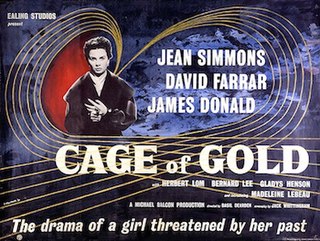
Cage of Gold is a 1950 British drama film directed by Basil Dearden, and starring Jean Simmons, David Farrar, and James Donald.
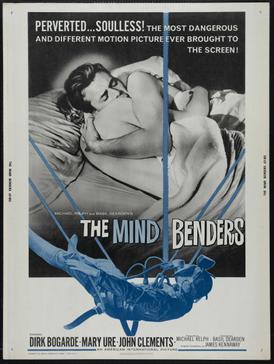
The Mind Benders is a 1963 British thriller film produced by Michael Relph, directed by Basil Dearden and starring Dirk Bogarde, Mary Ure, John Clements, Michael Bryant and Wendy Craig. Screenwriter James Kennaway turned his screenplay into his 1963 novel of the same name.
Janet Green (1908–1993) was a British screenwriter and playwright best known for the scripts for the BAFTA nominated films Sapphire and Victim, and for the play Murder Mistaken.

Flight attendants appear in films, television and printed works. This is a list of some appearances.
Peter Bezencenet (1914–2003) was a British film editor and film director. He co-scripted the 1936 film Conquest of the Air. He was employed by the Rank Organisation on a number of films during the 1950s, including several for Ealing Studios. He also acted as location director for the television series Richard the Lionheart in the early 1960s. During the 1960s he directed four films and episodes of the TV series The Pursuers.



















